
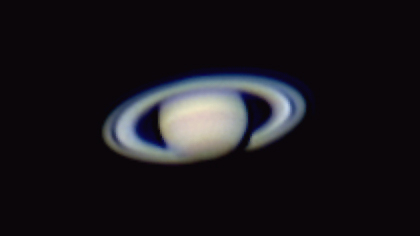


On the night of Apr 8/9, 2005 EDT, we tested the RIT Observatory's 12-inch Meade telescope and ToUCam webcam by taking pictures of Saturn and Jupiter. RIT Physics major George Privon came out to help me. It made the operation much smoother, since we were doing a lot of focusing as we changed the optical arrangment.
The weather was pretty good on this spring night: the skies were clear and the air very still. The daytime temperature had been in the low fifties Fahrenheit, but the temperature dropped as night fell. In the dome at 8:20 PM, the temperature was 12 degrees Celsius.
Notes from the setup:
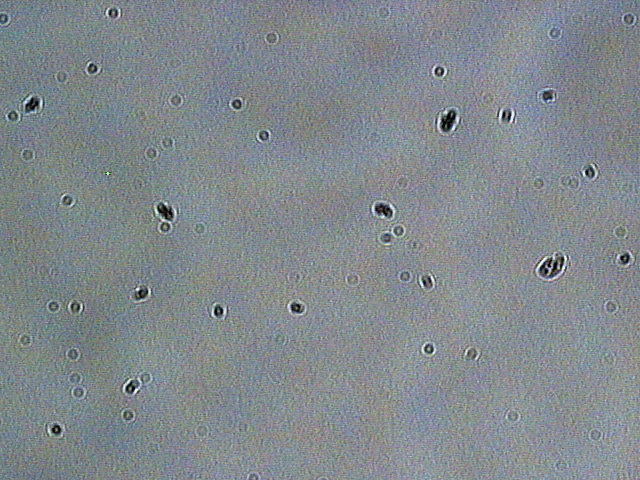
We should make a simple mask of diffusing material for the front of the telescope.
We grabbed several video clips of Saturn and Jupiter. At a rate of 5 frames per second, and a size of 640 x 480 pixels, the uncompressed color ToUCam video is about 120 MB per minute. Saturn was relatively high in the sky, altitude 58 degrees and airmass 1.2. Jupiter, on the other hand, was very low: only about 30 degrees above the eastern horizon, at airmass 2.0. As you'll see, the images of Saturn are much sharper than those of Jupiter -- which makes sense.
We first took images of Saturn without a Barlow lens. An exposure time setting of 1/33 of a second looked best. Here's a single frame from the raw movie:

The ball of the planet covers about 48 pixels; since the planet was about 18 arcsec across, this yields a plate scale of about 0.33 arcsec per pixel at Cass focus. The apparent magnitude of Saturn was about V=0.1 on this night, at a distance of 9.0 AU from the Earth.
I used Registax to stack and combine many frames from our video clips. Here are stacks of (upper row) 10, 103, (lower row) 293, and 456 frames (taken from a total set of 600 frames). Each image is zoomed by a factor of 2.
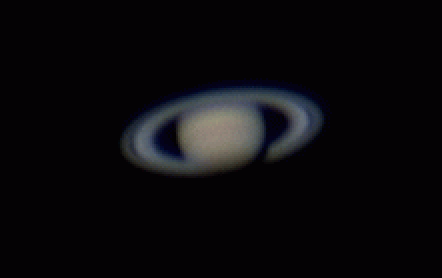
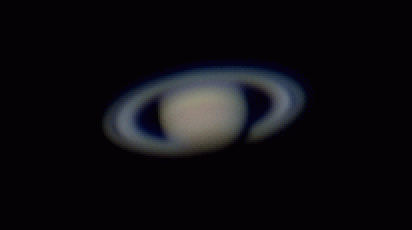
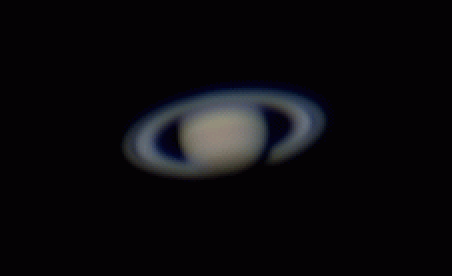
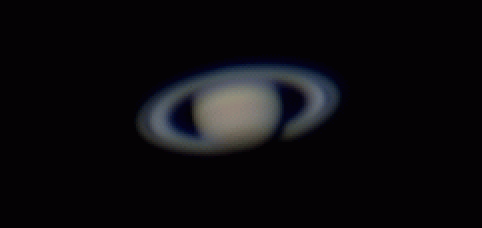
To my eyes, the 103-frame and 293-frame stacks looked best, and about the same. I carried the 293-frame stack forward to Registax's "wavelet processing" stage. The layers numbered 2 and 3 seemed to bring out detail best, so I set them to value 10.0 and left all other layers at 1.0. Below are a single raw frame, then the final stacked and sharpened image, at its original size and zoomed by a factor of 2.
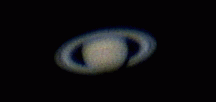
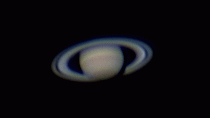

Finally, I used Photoshop to "despeckle" the image and boost the brightness a bit. Hmmm. Compare the final output of Registax on left (same as above), and then the version enhanced with Photoshop on right.


We also tried some pictures of Saturn with the Barlow lens. The image was much dimmer: even at the maximum exposure time of 1/25 = 0.04 seconds, it was clearly underexposed. We had to turn the gain up to about 40 percent to see any real detail. Here's a still from the raw video:

You can see the noise in the background and the single hot pixel in our ToUCam. I was unable to figure out how to use the "dark frame" and "flat frame" options in Registax properly; it didn't seem to make much of a difference for the hot pixel, but, as you'll see in the pictures of Jupiter with Barlow lens, the dust specks on the camera are very annoying (and would be removed by flatfielding, if I could just figure out how!).
The planet's ball is about 123 pixels across; thus, with Barlow lens, the plate scale is about 0.15 arcsec per pixel, or a factor of about 2.5 times smaller than without the Barlow. Yup, the Edmund RKE Barlow lens is said to be 2.5x, so this all makes sense.
I used Registax to combine many images again. Out of 600 raw frames, the best 200 produce this composite before sharpening (on left), and after sharpening (on right). In this case, the important wavelet layers were 5 and 6, which I set to 15 and 30, respectively (all the rest were left at 1.0).
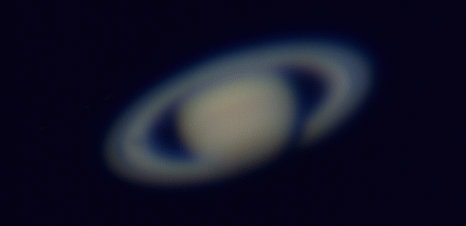

Note that the hot pixel appears in this sharpened composite on the right. Note also that the sharpening didn't do much to help the image. Overall, the image without Barlow is better: compare the two side-by-side at a nearly common scale.


I processed our video clips of Jupiter in much the same way as those of Saturn. Due to the larger airmass of Jupiter, the results are less impressive overall.
Here are images taken at Cass focus: from left to right,
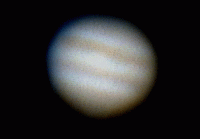
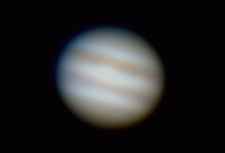
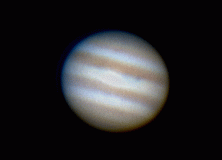
I made an enlarged version of the sharpened image with the "Resize" option in Registax, doubling it. Compare the image to a chart of Jupiter for this date and time, courtesy of xephem .

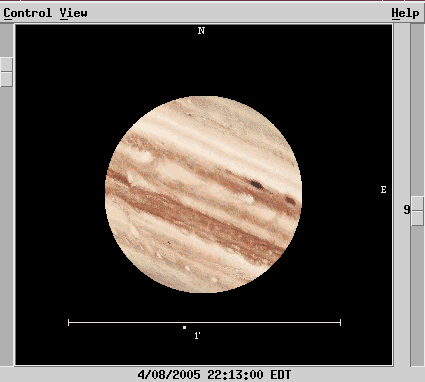
The blank white patch in the middle of the image shows me that we overexposed Jupiter just a bit. Our exposure time was 1/25 second; next time, we should make it 1/33 or 1/50 at Cass focus.
We tried taking images of Jupiter with the Barlow lens in place, too, but it was no good: the atmosphere just blurred everything out. The specks of dust on the camera window (or chip itself?) also became very apparent, as this raw frame shows:

I really want to figure out how to use flatfields in Registax!
We also made a quick test of the PC-164C video camera and Kiwi OSD video time insertion unit. It was the first time we'd set up the Kiwi OSD at the Observatory. George placed the GPS receiver on a stool which was sitting on the sidewalk outside the dome. I connected the Kiwi unit to the PC-164C video camera and the GPS cable ... and it all just worked. Very nice! The GPS receiver reported:
We pointed the telescope at Saturn to see how faint an object we could detect. George drew a sketch of the television screen; the numbers on his sketch indicate the relative brightness of the objects (1 = brightest, 6.5 = faintest)
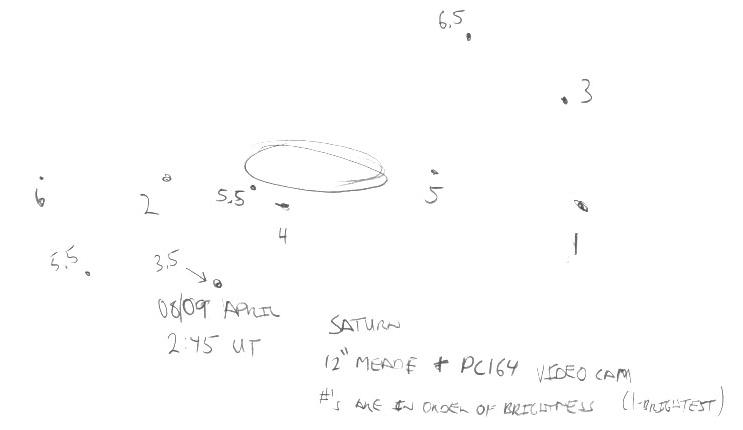
Compare his drawing to a chart of the brighter moons of Saturn from Xephem.
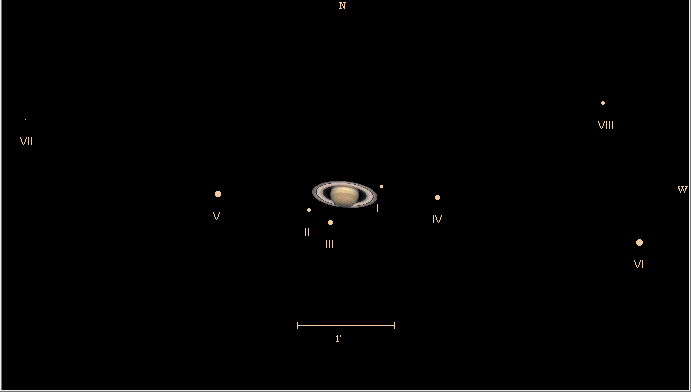
The moons are:
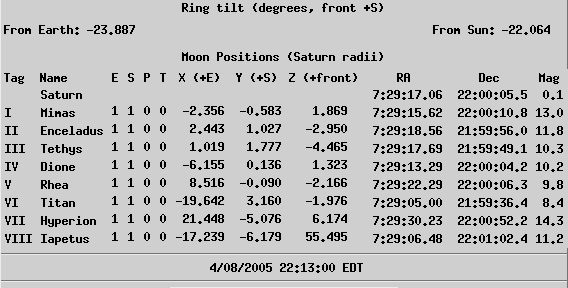
We clearly saw VIII=Iapetus, at mag 11.2. The moon II=Enceladus was hard to see, perhaps because it was so close to the overexposed Saturn. At mag 11.8, it was the faintest moon we could see. The object on George's sketch to the west of the planet labelled "6" is not VII=Hyperion, I believe, but just a field star.
Based on this rather simple test, I'd place the limiting magnitude of the PC-164C at the Cass focus of our Meade 12-inch telescope to be about V=12. This is a bit fainter than the limiting magnitude for the same camera on our 16-inch telescope (see the summary table at the end of this page ), but that's not too surprising: the mirror of the 16-inch is filthy, and its larger plate scale spreads light out over more pixels.
Last modified 4/10/2005 by MWR.